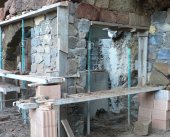posted 13 years ago
Dolman--I think a lot of people are in your position. My position is that if I don't step out and try it, I would be left struggling to get enough wood for a grossly polluting wood stove which had poor designs, too big uninsulated flue pipe causing a lot of creosote, burned through two FULL wheelbarrows full of wood a day(24 hours), and required multiple blowers and fans to get all the heat around. It was also located at the far end of the house against a concrete wall that was only partially underground, so that radiant heat was lost. I figured I had to redo the whole thing anyway, so here I go. One other factor was that a roof without a chimney is a lot easier to replace and less chance for any leaks(just replaced that section of roof and removed the flue piping).
On the factor of heating everything already IN the house for mass...most rocket stoves weigh a few tons. Mine will be probaby 6000+ pounds, plus a cinder block wall inches away that is freestanding in the middle of the basement. So for me, that trumps the kitchen table, t.v. and couches by about x10.
I would keep a wood stove I already had if it was nice, with a big viewing window, insulated flue, cold air inlet kit installed, and it had the afterburn air-injection option. Rocket heaters may be more efficient, but if you have something that is nice to use and look at already(and probably cost in the neighborhood of $2-3000 with the flue piping), then it would be REALLY hard to part with that for something made of mud and old oil tanks that doesn't have a lot of hard recorded R&D figures to go on.
What you COULD do is build a smaller one(maybe 2 pallets in the basement), and build it with stones, sand, fire bricks, and reclaimed materials to see how it goes(like the one on U-tube that they all moved with bicycles!). It will be a learning experience for anyone, just as installing and using a wood stove is. I remember installing my first wood stove and being so confused with all the clearance numbers, ceiling air gap spacer things, roof flashing, all the flue pieces, underlayment, wall heat shields, and then learning how to use the damper and air inlet slide valve thing, and then all the different kinds of woods and how they burn, and the moisture levels affecting that, and then overburning where all the paint would smoke up the house. It was so confusing and stinky and dirty and a pain to keep up, but I still have good memories of it, and now I could probably install a wood stove in a couple hours with one hardware store trip.






















































